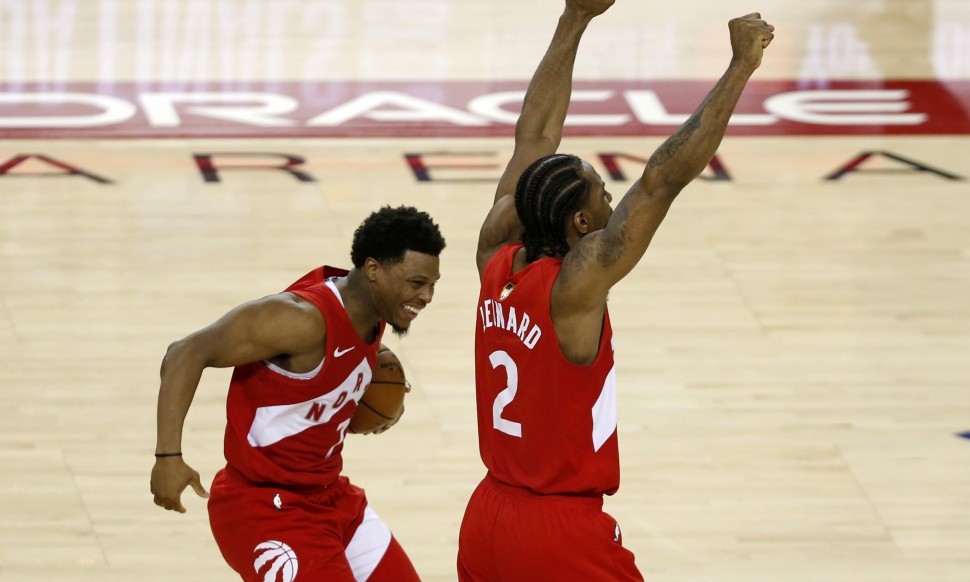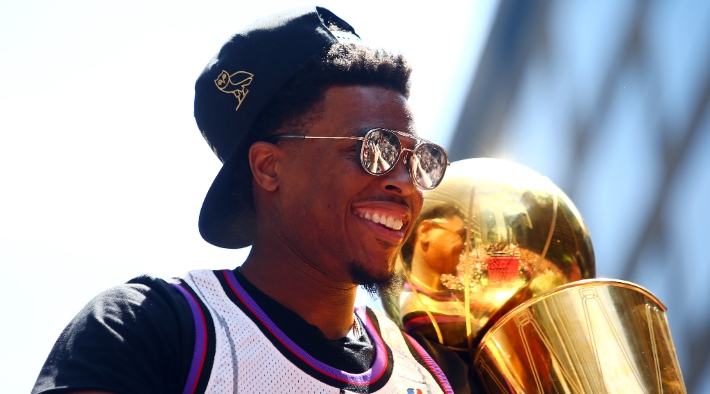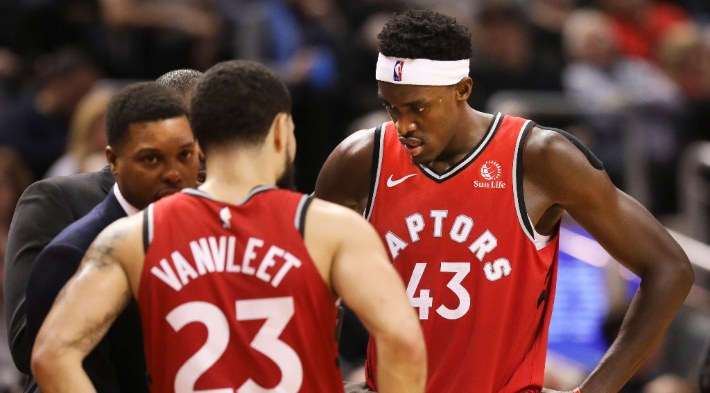TORONTO — “I think everybody’s seeing it out there,” Kyle Lowry said after the Raptors lost to former teammate Kawhi Leonard and the Clippers. “We’re just not playing on a rope.”
Lowry had a point. Against the Clippers, Toronto looked like they were shadow boxing. The moves that would normally work in dispatching an opposing team — defensive pressure, ball movement, patience — were being feinted right back at them. When Doc Rivers was asked before the game about Leonard’s effect on the Clippers, he said the team was “almost a good fit for him to begin with, a gritty, tough-minded defensive group of guys.” It made it so that when Leonard arrived, “he just fit in.”
And no wonder. The Raptors had effectively given the Clippers the model in which to outplay them, because it was Toronto’s own blueprint.
In Toronto, where for so long players sought out advantages in the grittier, admittedly uglier elements of the game, Leonard brought a new kind of polish in his statuesque approach. The Raptors, who had always played comfortably as a band of disparate pieces, gained a new pedigree, but used it to refine the rough parts. In Los Angeles, Leonard came to a team that was perpetually firing on all cylinders. The collective energy brought by Lou Williams and Patrick Beverley and Montrezl Harrell made the Clippers a nuisance, but what the Clippers lacked was a cohesive engine to fuse everything together.
Leonard could be that, as he had just helped get Toronto the championship by doing the same. The question for Toronto then became one of identity, of what’s left after a great big star’s meteoritic impact has gone. Can a team slip easily back into what used to be their standard operating procedure or do they need to augment altogether, and in Toronto’s case, who is responsible for getting them there?

What Lowry meant by not playing on a rope was the kind of cohesion that can make a team look like they’re moving as one, like every player is going to respond to his teammates as if tethered. For his entire career in Toronto, Kyle Lowry has been one back from the lead of that line.
In the 2013-14 season, Lowry and DeMar DeRozan made a decision. Knowing neither of them was guaranteed a spot if the Raptors decided to enter into a rebuild, which was the expected move of new GM Masai Ujiri, Lowry and DeRozan stepped into the role of the team leaders. The Raptors would see the postseason for the first time since 2008, winning the Atlantic Division for the second time in franchise history.
Up until then, the two hardly spoke, but their off-court rapport soon matched the chemistry they shared on the court, a balancing and protective energy best and most heartbreakingly exemplified when, after Paul Pierce blocked what would have been his game winning shot in the first round of the playoffs, Lowry crumpled to the floor and DeRozan immediately went to him to put his body between Lowry’s and the crowd. Reality was, for a few long, silent seconds, held off.
This was the kind of space DeRozan and Lowry created for one another as running mates of the franchise: Lowry’s role as buoyant, territorial spark plug, while louder, took a slight backseat to DeRozan’s growing profile and steadier leadership. But no matter the stats DeRozan would put up or the games he’d icily put away for Toronto, Lowry did the legwork. The kind of ten-things-at-once, immeasurable things that ultimately won games by giving the Raptors an edge were checked off the list by Lowry — taking charges, deflecting screens, tussling for rebounds with guys twice his size and getting tanged up, hard, on the way down. Lowry has always hit the floor like he was spring-loaded, back up and away before the ball was over the half-court line.
Lowry and DeRozan took the Raptors farther than they’d ever come for five straight seasons. The two of them shaped the franchise, ironically, to a readiness that neither of them, alone or together, could move into the next level of competition. When DeRozan was traded for Leonard, Lowry lost his best friend and was left with a franchise whose legacy was, up to then, one of losing its leaders.
After the initial buy-in time — for Leonard, his apparent reluctance in the city and franchise, for Lowry, his guarded first month alongside DeRozan’s proxy and ghost — Lowry seemed to make a decision. Representing his team’s best road to the postseason and run at all the walls that had stopped the Raptors before, Lowry handed the reins of the team he’d built and rebuilt over to Leonard.

Leonard served as a stabilizing force for the Raptors, bringing a sense of calm and knowing to a group that otherwise played on the sharpest of edges. Lowry, meanwhile, became an adept playmaker, generous and confident in the younger core of Fred VanVleet, Pascal Siakam, and Norman Powell, and let Leonard take the lead and limelight of a team that quickly closed the gap from however many years away to being there, in the year to end them all.
With Leonard leading and Lowry as the keeper of all that institutional knowledge, the Raptors identity appeared, finally, bona fide. They weren’t stand-ins for something coming along later, this was the group that was going to do it. Lowry must have also seen how the road could have ended for him in Toronto a season after DeRozan’s and win or lose, the next chapter was going to be on his own. What no team or its players can understand until it happens is winning a championship, and depending on how much of that team stays together into the next season, what the year after will look like.
Lowry started this season with the Raptors, for the first time ever, as the only candidate for the team’s leader. Leonard was gone and Siakam had questions to answer about stepping into a starring role on the floor, much less in the locker room. It was a role that was underscored by a one-year, $31 million extension for Lowry. The franchise believed in him and the fans, finally, did too. His returning teammates already knew the value and guts of the guy who’d played from the second round on with a torn tendon in his left thumb and opted to wear an oven mitt for any minutes he wasn’t playing until the Finals were over.
Lowry was averaging 21 points, five rebounds and continuing to lead by enabling opportunities for his teammates with an average of seven assists when he fractured the same thumb two weeks into the Raptors defending season. While he was out, he watched from the bench as a Toronto rotational lineup that turned deeper the weirder it got took over. Here again was a cast of disparate pieces, no clear leader, but the team was excelling. There was a persistent, hard-fought and energetic quality in play, as the team found itself in an odd spot as champions and outliers.
Since Lowry has come back, there has been a dip in momentum. When asked after the loss to Leonard and the Clippers if he’d gotten his rhythm back, Lowry was adamant: “No, no. I’ve had two good games and the rest have been shit, to be honest.” He also held tight to the same reasoning as his coach and teammates, saying, “Once I get back to where I was at the beginning of the season, it will be great.”
So much of the way Lowry has worked is alongside a narrative. Whether it was one of friendship or a superstar briefly crashed into his orbit, it was within these stories that he could get to work adjusting the expectations of what winning and being considered competitive could mean. He played against them, using them for balance or fuel. Now that he is without one, the lurch seems inevitable. Just as the Clippers can’t know everything Leonard is going to mean to them, the Raptors still can’t know all the aftershocks he’ll bring as they continue to, in many ways, deconstruct. It’s painstaking and slow work of shearing facade from the bones of the team and has no better hands to fall into than the one who has carried the pieces and put them together, again and again.

Because there is a way that Lowry gains a counterpart while still leading, he’s been doing it for a few seasons now. The current lurches and energy shifts Toronto faces on the floor a lot of the time have to do with no clear decision maker in the absence of Lowry. This is where defense is forgotten, ball movement gets erratic, rhythm goes off and shooting takes a dive. Lowry has a knack for controlling the clock, for taking time between his hands, in the form of a basketball, and driving. He’s been a pacemaker for Toronto and brought the team back from a flatline even during seasons with front office mandated DNR orders.
And now, with key pieces out indefinitely in a short season that was already riddled with injury, Lowry is going to have to bandage and carry a beleaguered team with more than just an energy deficiency to worry about. But Lowry’s growth as a leader has become as cerebral as his gameplay. In the redistribution of weight that he’s felt through DeRozan and Leonard leaving, Lowry has learned what it means to adjust in real time, to leverage his experience for longterm team development and other times, like now, to know when it’s just time to triage. In many ways, he has never been better prepared for such an unfortunate string of injuries to befall his team, nor could the Raptors hope for a better emergency responder.
As Toronto’s core shifts over to Siakam, VanVleet, Powell, and OG Anunoby, Lowry has the opportunity to push the team somewhere new by formalizing its next leaders. If he can lead by shirking the narrative of what a leader ought to look like and, instead, steps back to encourage the next person forward, his identity within the team could become one of legacy. None of Toronto’s previous franchise leaders, favorites, or stars ever stayed this long, so none were in positions where they could lay out a tenable roadmap for the future like this.
Lowry’s rope, whether back to his team or himself, has always been basketball. Oversimplified maybe, but everything else — his attitude and the running commentary on it, his longevity in the league, his talent — is an outcome of not taking Lowry at face value. When he talked about what was going awry in his game and how he was going to fix it, the answer was without rhetoric, completely tangible: “Work my way in and try to figure it out.” It’s how you let Lowry lead.







